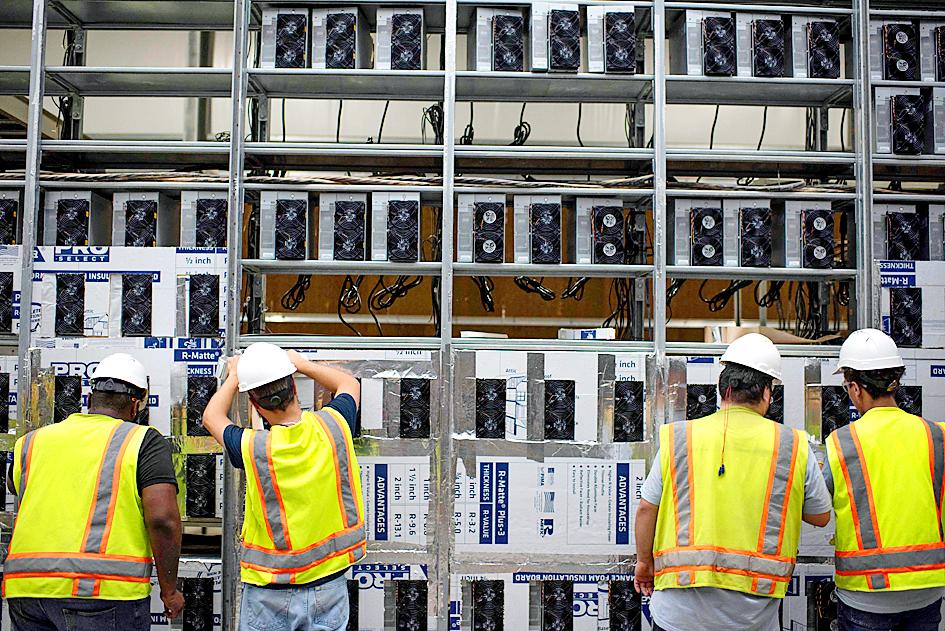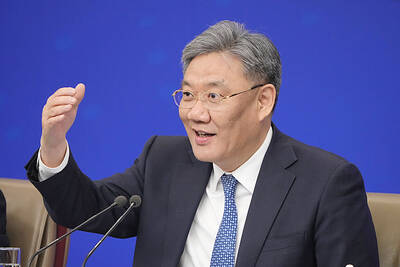The long sheds at North America’s largest bitcoin mine look endless in the Texas sun, packed with the type of machines that have helped the US to become the new global hub for the digital currency.
The operation in the quiet town of Rockdale was part of a bustling US business that received a boost from Beijing’s intensified cryptocurrency crackdown, which pushed the industry westward.
Experts say that the rule of law and cheap electricity in the US are a draw for bitcoin miners, whose energy-gulping computers race to unlock units of the currency.

Photo: AFP
“There are a lot of competitors coming into Texas because they are seeing the same thing [as] when we came here,” said Chad Everett Harris, CEO of miner Whinstone, which operates the Rockdale site owned by US company Riot Blockchain.
China was the undisputed heartland of cryptocurrency mining, with about two-thirds of the global capacity in September 2019, but last month, Beijing declared illegal all transactions involving cryptocurrency, as it seeks to launch one of its own.
Figures released on Wednesday by the University of Cambridge showed that activity in the US more than doubled in the four months to the end of August, increasing the market share held by the world’s biggest economy to 35.4 percent.
Samir Tabar, chief strategy officer at miner Bit Digital, said that the company started to pull out of China last year and accelerated that process as the crackdown intensified.
The firm has operations in the US and Canada.
“China’s bitcoin mining ban was basically an unintentional gift to the US,” he said. “Thanks to their ban, an entire sector migrated to North America — along with innovation, labor and machines.”
Some of the key pulls toward the US are simply a democratic government, a court system and the power to protect property rights.
“If you’re going to make long-term investments and accumulate wealth in a country, you want to have some confidence that it’s not going to be taken away by the government,” said David Yermack, a cryptocurrency expert at New York University.
He expected the shift to the US to be temporary, saying that places like Nordic countries have cheap and abundant renewable energy, as well as plenty of cold weather to cool the hot-running mining machines.
The steady increase in US-based mining operations has fanned the ongoing environmental criticisms of the industry’s massive annual electricity consumption — more than what the Philippines uses in a year, Cambridge University data showed.
An ongoing backlash has been fueled by concerns that the industry relies on carbon-emitting power sources that contribute to climate change.
“To think that we’re causing harm or pollution or all those things here... The majority of our power comes out of the ERCOT grid and that profile is extremely friendly to the environment,” Harris said, referring to the Texas power network operator.
According to ERCOT’s data for last year, about 46 percent of its power came from natural gas, while wind and solar combined for 25 percent, with coal at 18 percent.
The price miners pay for electricity is key, and a place like Texas is desirable because the market is deregulated, so companies can have more flexible terms, Georgetown University business school professor Viktoriya Zotova said.
“In principle, they can buy the electricity when it’s cheaper and not buy it when it’s more expensive,” she said.
While there are obvious reasons for the cryptocurrency world’s migration, some also see a bit of poetry in mining operations coming to the US from China.
Tabar said that Bit Digital has a site in Buffalo, New York, which used to be one of the country’s main manufacturing hubs, but lost jobs and prosperity as production work shifted to places like China.
“There is a bit of a poetic thing going on — it dawned on me how this is going full circle,” he said.

‘EYE FOR AN EYE’: Two of the men were shot by a male relative of the victims, whose families turned down the opportunity to offer them amnesty, the Supreme Court said Four men were yesterday publicly executed in Afghanistan, the Supreme Court said, the highest number of executions to be carried out in one day since the Taliban’s return to power. The executions in three separate provinces brought to 10 the number of men publicly put to death since 2021, according to an Agence France-Presse tally. Public executions were common during the Taliban’s first rule from 1996 to 2001, with most of them carried out publicly in sports stadiums. Two men were shot around six or seven times by a male relative of the victims in front of spectators in Qala-i-Naw, the center

Incumbent Ecuadoran President Daniel Noboa on Sunday claimed a runaway victory in the nation’s presidential election, after voters endorsed the young leader’s “iron fist” approach to rampant cartel violence. With more than 90 percent of the votes counted, the National Election Council said Noboa had an unassailable 12-point lead over his leftist rival Luisa Gonzalez. Official results showed Noboa with 56 percent of the vote, against Gonzalez’s 44 percent — a far bigger winning margin than expected after a virtual tie in the first round. Speaking to jubilant supporters in his hometown of Olon, the 37-year-old president claimed a “historic victory.” “A huge hug

Canadian Prime Minister Mark Carney is leaning into his banking background as his country fights a trade war with the US, but his financial ties have also made him a target for conspiracy theories. Incorporating tropes familiar to followers of the far-right QAnon movement, conspiratorial social media posts about the Liberal leader have surged ahead of the country’s April 28 election. Posts range from false claims he recited a “satanic chant” at a campaign event to artificial intelligence (AI)-generated images of him in a pool with convicted sex offender Jeffrey Epstein. “He’s the ideal person to be targeted here, for sure, due to

DISPUTE: Beijing seeks global support against Trump’s tariffs, but many governments remain hesitant to align, including India, ASEAN countries and Australia China is reaching out to other nations as the US layers on more tariffs, in what appears to be an attempt by Beijing to form a united front to compel Washington to retreat. Days into the effort, it is meeting only partial success from countries unwilling to ally with the main target of US President Donald Trump’s trade war. Facing the cratering of global markets, Trump on Wednesday backed off his tariffs on most nations for 90 days, saying countries were lining up to negotiate more favorable conditions. China has refused to seek talks, saying the US was insincere and that it